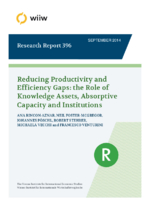Reducing Productivity and Efficiency Gaps: the Role of Knowledge Assets, Absorptive Capacity and Institutions
Neil Foster-McGregor, Johannes Pöschl, Ana Rincon-Aznar, Robert Stehrer, Michaela Vecchi and Francesco Venturini
wiiw Research Report No. 396, September 2014
165 pages including 38 Tables and 83 Figures
Summary
This study analyses the impact of knowledge assets on productivity and technical efficiency in the EU, as well as their role in the process of knowledge transfer. The analysis covers the role of the institutional and regulatory environment in affecting productivity and technical efficiency and how different regulations interact with both the accumulation of knowledge assets and the transfer of technology. Special emphasis is put on the analysis of trends and performance within the EU, across countries and sectors. The trends and performance of the EU at aggregate and sectoral levels are also contrasted with those of other major competitors, such as the United States, Japan or Korea. Further, the effects of the recent crisis on productivity and efficiency at firm level are explored.
Keywords: competitiveness, industrial organisation, manufacturing, services
JEL classification: O11, O12, O43, O57, L60
Countries covered: European Union, Japan, Korea, USA
Research Areas: Macroeconomic Analysis and Policy, International Trade, Competitiveness and FDI, Sectoral studies
